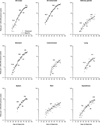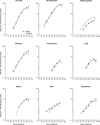Incidence of marginal zone lymphoma in the United States, 2001-2009 with a focus on primary anatomic site
- PMID: 24417667
- PMCID: PMC3967856
- DOI: 10.1111/bjh.12730
Incidence of marginal zone lymphoma in the United States, 2001-2009 with a focus on primary anatomic site
Abstract
The aetiology of marginal zone lymphoma (MZL) is purported to differ by anatomic site. While this is supported by clinical series of single MZL sites, no population-based study has comprehensively assessed incidence patterns across sites. To gain insight into disease aetiology, we assessed MZL incidence by site using data from 18 U.S. Surveillance, Epidemiology and End Results (SEER) Program population-based registries. We calculated age-adjusted incidence rates (IRs) by sex, race, and calendar year. During 2001-2009, 4,081 (IR = 5·7/1,000,000 person-years) and 8,821 (IR = 12·3) individuals were diagnosed with nodal MZL and extranodal MZL, respectively. The most common extranodal sites were stomach (IR = 3·8), spleen (IR = 1·6), eye/adnexa (IR = 1·4), and lung, skin, and salivary glands (IRs = 0·9-1·0). We observed distinct age-specific patterns by MZL site, with IRs increasing steeply at younger ages and less prominently after mid-life at several sites, except skin. Gender and racial/ethnic disparities were also apparent across sites. Between 2001-2005 and 2006-2009, MZL IRs decreased significantly for gastric (-15%) and soft tissue (-28%) sites, whereas IRs increased significantly for lung (18%), skin (43%), and kidney/renal pelvis (116%). In combination, our findings support the contention that MZL is characterized by aetiological heterogeneity across sites and susceptibility is probably influenced by intrinsic characteristics and environmental exposures.
Keywords: anatomic site; incidence; joinpoint analysis; marginal zone lymphoma; population-based study.
© 2014 John Wiley & Sons Ltd.
Conflict of interest statement
Figures


References
-
- Agelli M, Clegg LX. Epidemiology of primary Merkel cell carcinoma in the United States. J Am Acad Dermatol. 2003;49:832–841. - PubMed
-
- Ahmed R, Al-Shaikh S, Akhtar M. Hashimoto thyroiditis: a century later. Adv Anat Pathol. 2012;19:181–186. - PubMed
-
- Alberg AJ, Ford JG, Samet JM. Epidemiology of lung cancer: ACCP evidence-based clinical practice guidelines. Chest. (2nd edition) 2007;132:29S–55S. - PubMed
-
- Armitage P, Doll R. The age distribution of cancer and a multi-stage theory of carcinogenesis. 1954. Int J Epidemiol. 2004;33:1174–1179. - PubMed
-
- Bayerdorffer E, Neubauer A, Rudolph B, Thiede C, Lehn N, Eidt S, Stolte M. Regression of primary gastric lymphoma of mucosa-associated lymphoid tissue type after cure of Helicobacter pylori infection. MALT Lymphoma Study Group. Lancet. 1995;345:1591–1594. - PubMed
Publication types
MeSH terms
Grants and funding
LinkOut - more resources
Full Text Sources
Other Literature Sources

